check engine YAMAHA FX HO CRUISER 2019 Owners Manual
[x] Cancel search | Manufacturer: YAMAHA, Model Year: 2019, Model line: FX HO CRUISER, Model: YAMAHA FX HO CRUISER 2019Pages: 116, PDF Size: 12.33 MB
Page 6 of 116

Table of contents
Draining the bilge water ................ 59
Draining the bilge water on land ...... 59
Draining the bilge water on water .... 60
Transporting on a trailer ................ 61
First-time operation ........................ 62
Engine break-in ............................. 62
Pre-operation checks ..................... 63
Pre-operation checklist .................... 63
Pre-operation check points........... 65
Pre-launch checks ........................... 65
Post-launch checks ......................... 71
Operation ......................................... 73
Operating your watercraft ............. 73
Getting to know your watercraft ...... 73
Learning to operate your
watercraft ...................................... 73
Riding position ................................. 74
Launching the watercraft ................. 74
Starting the engine on water ............ 74
Stopping the engine ......................... 75
Leaving the watercraft...................... 75
Operating the watercraft .................. 75
Turning the watercraft ...................... 76
Stopping the watercraft ................... 77
Operating the watercraft in reverse
or neutral ...................................... 78
Boarding the watercraft ................... 79
Starting off........................................ 81
Capsized watercraft ......................... 82
Beaching and docking the
watercraft ...................................... 83
Operating in weeded areas .............. 83
After removing the watercraft from
the water ....................................... 84
Care and storage............................. 85
Post-operation care ...................... 85
Flushing the cooling water
passages....................................... 85
Cleaning the watercraft .................... 86
Battery care ...................................... 86
Long-term storage ........................ 89
Cleaning ........................................... 89
Lubrication ....................................... 89
Rustproofing ..................................... 89
Maintenance .................................... 90
Maintenance ................................. 90
Tool kit.............................................. 90
Removing and installing the engine
cover ............................................. 90
Periodic maintenance chart ............. 92
Engine oil and oil filter ...................... 94
Specifications .................................. 95
Specifications ............................... 95
Trouble recovery ............................. 96
Troubleshooting ............................ 96
Troubleshooting chart ...................... 96
Emergency procedures ................ 99
Cleaning the jet intake and
impeller ......................................... 99
Raising the reverse gate ................ 100
Jumping the battery ....................... 100
Replacing the fuses ........................ 101
Towing the watercraft..................... 103
Submerged watercraft ................... 103
Index............................................... 105
UF3V70E0.book Page 2 Tuesday, August 28, 2018 10:16 AM
Page 18 of 116
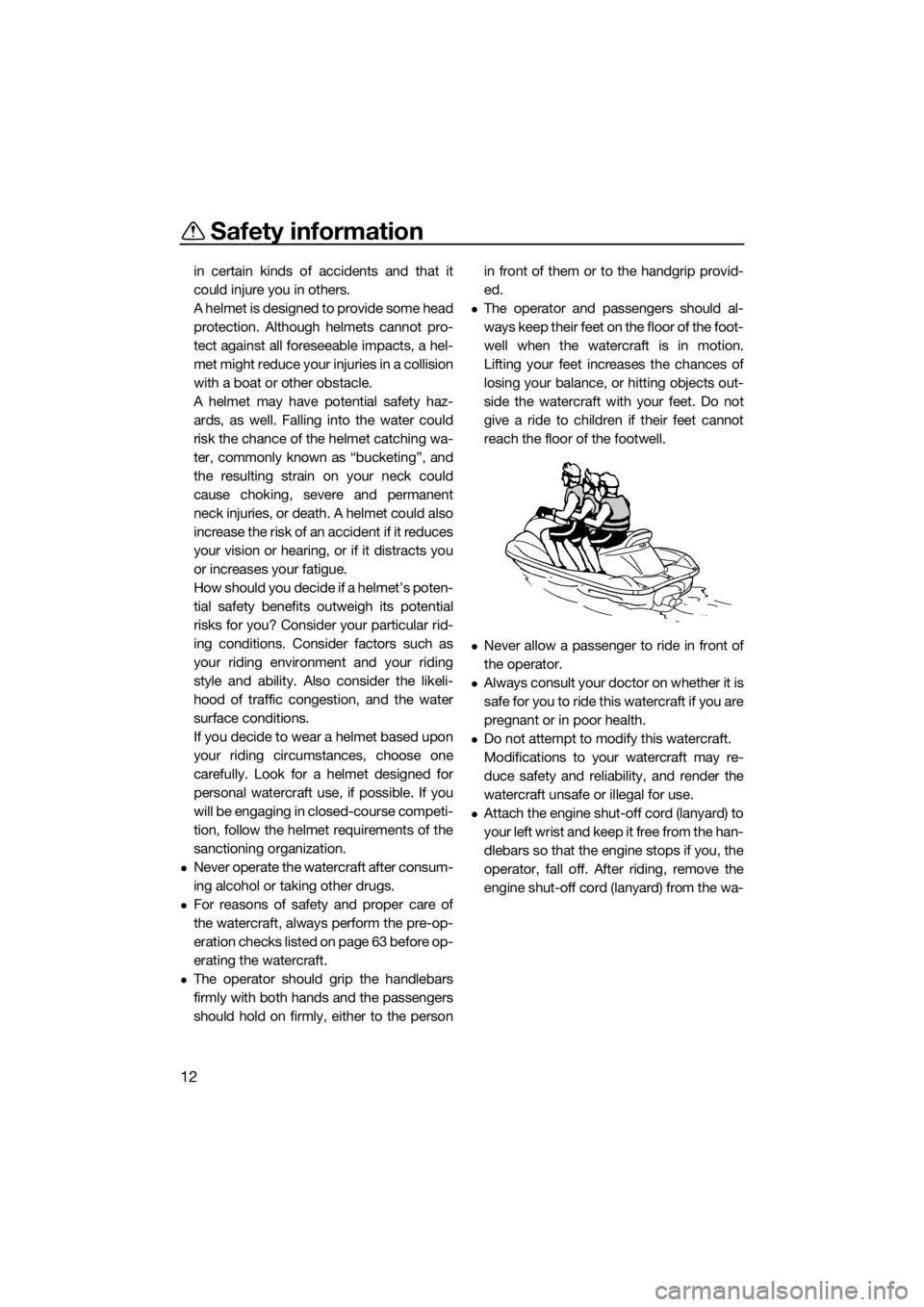
Safety information
12
in certain kinds of accidents and that it
could injure you in others.
A helmet is designed to provide some head
protection. Although helmets cannot pro-
tect against all foreseeable impacts, a hel-
met might reduce your injuries in a collision
with a boat or other obstacle.
A helmet may have potential safety haz-
ards, as well. Falling into the water could
risk the chance of the helmet catching wa-
ter, commonly known as “bucketing”, and
the resulting strain on your neck could
cause choking, severe and permanent
neck injuries, or death. A helmet could also
increase the risk of an accident if it reduces
your vision or hearing, or if it distracts you
or increases your fatigue.
How should you decide if a helmet’s poten-
tial safety benefits outweigh its potential
risks for you? Consider your particular rid-
ing conditions. Consider factors such as
your riding environment and your riding
style and ability. Also consider the likeli-
hood of traffic congestion, and the water
surface conditions.
If you decide to wear a helmet based upon
your riding circumstances, choose one
carefully. Look for a helmet designed for
personal watercraft use, if possible. If you
will be engaging in closed-course competi-
tion, follow the helmet requirements of the
sanctioning organization.
Never operate the watercraft after consum-
ing alcohol or taking other drugs.
For reasons of safety and proper care of
the watercraft, always perform the pre-op-
eration checks listed on page 63 before op-
erating the watercraft.
The operator should grip the handlebars
firmly with both hands and the passengers
should hold on firmly, either to the personin front of them or to the handgrip provid-
ed.
The operator and passengers should al-
ways keep their feet on the floor of the foot-
well when the watercraft is in motion.
Lifting your feet increases the chances of
losing your balance, or hitting objects out-
side the watercraft with your feet. Do not
give a ride to children if their feet cannot
reach the floor of the footwell.
Never allow a passenger to ride in front of
the operator.
Always consult your doctor on whether it is
safe for you to ride this watercraft if you are
pregnant or in poor health.
Do not attempt to modify this watercraft.
Modifications to your watercraft may re-
duce safety and reliability, and render the
watercraft unsafe or illegal for use.
Attach the engine shut-off cord (lanyard) to
y o u r l ef t w r is t an d k ee p i t fr e e f r o m t h e h an -
dlebars so that the engine stops if you, the
operator, fall off. After riding, remove the
engine shut-off cord (lanyard) from the wa-
UF3V70E0.book Page 12 Tuesday, August 28, 2018 10:16 AM
Page 21 of 116
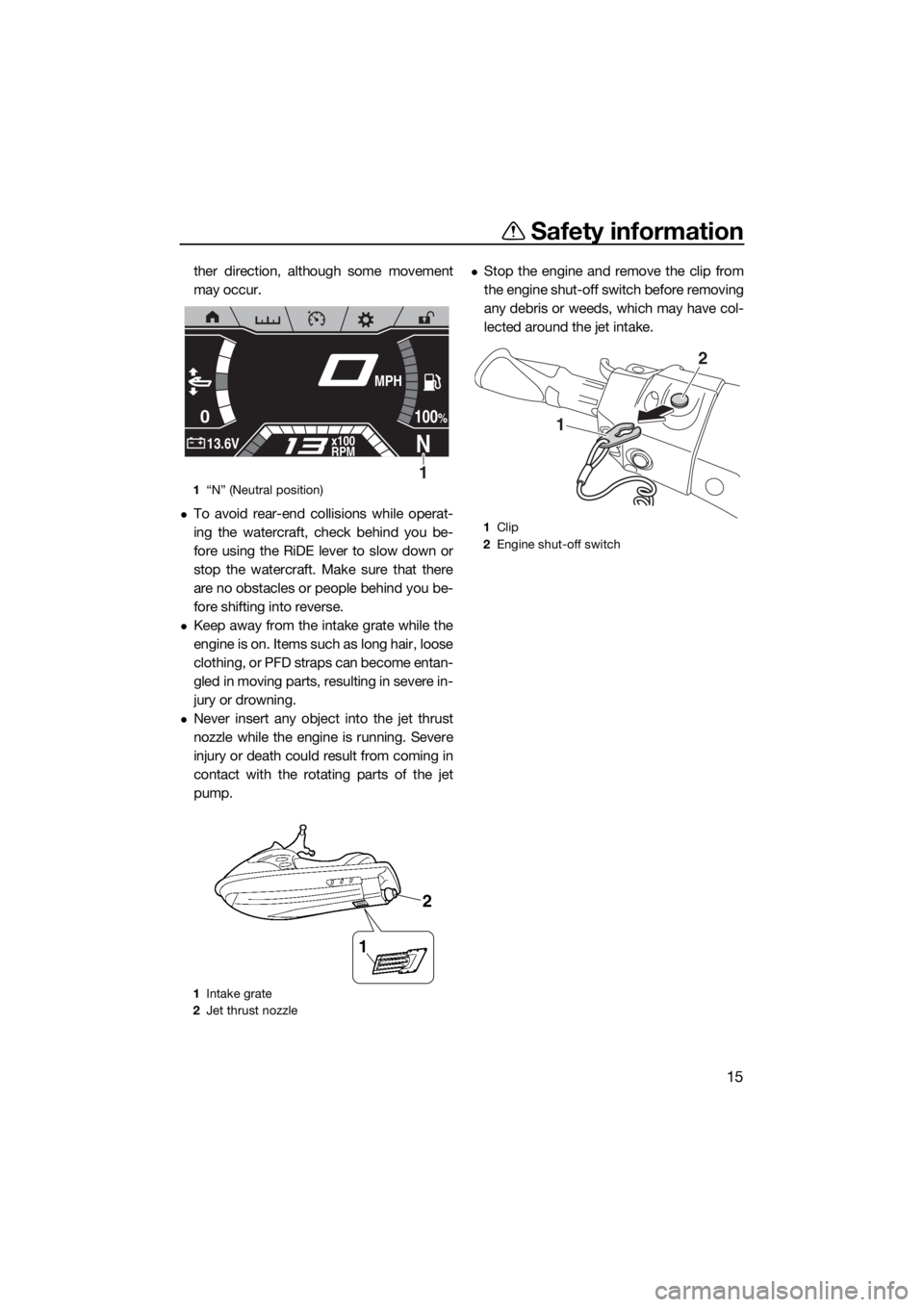
Safety information
15
ther direction, although some movement
may occur.
To avoid rear-end collisions while operat-
ing the watercraft, check behind you be-
fore using the RiDE lever to slow down or
stop the watercraft. Make sure that there
are no obstacles or people behind you be-
fore shifting into reverse.
Keep away from the intake grate while the
engine is on. Items such as long hair, loose
clothing, or PFD straps can become entan-
gled in moving parts, resulting in severe in-
jury or drowning.
Never insert any object into the jet thrust
nozzle while the engine is running. Severe
injury or death could result from coming in
contact with the rotating parts of the jet
pump.
Stop the engine and remove the clip from
the engine shut-off switch before removing
any debris or weeds, which may have col-
lected around the jet intake.
1“N” (Neutral position)
1Intake grate
2Jet thrust nozzle
0
N13.6Vx100
RPM
100%
MPH
1
1
2
1Clip
2Engine shut-off switch
2
1
UF3V70E0.book Page 15 Tuesday, August 28, 2018 10:16 AM
Page 34 of 116
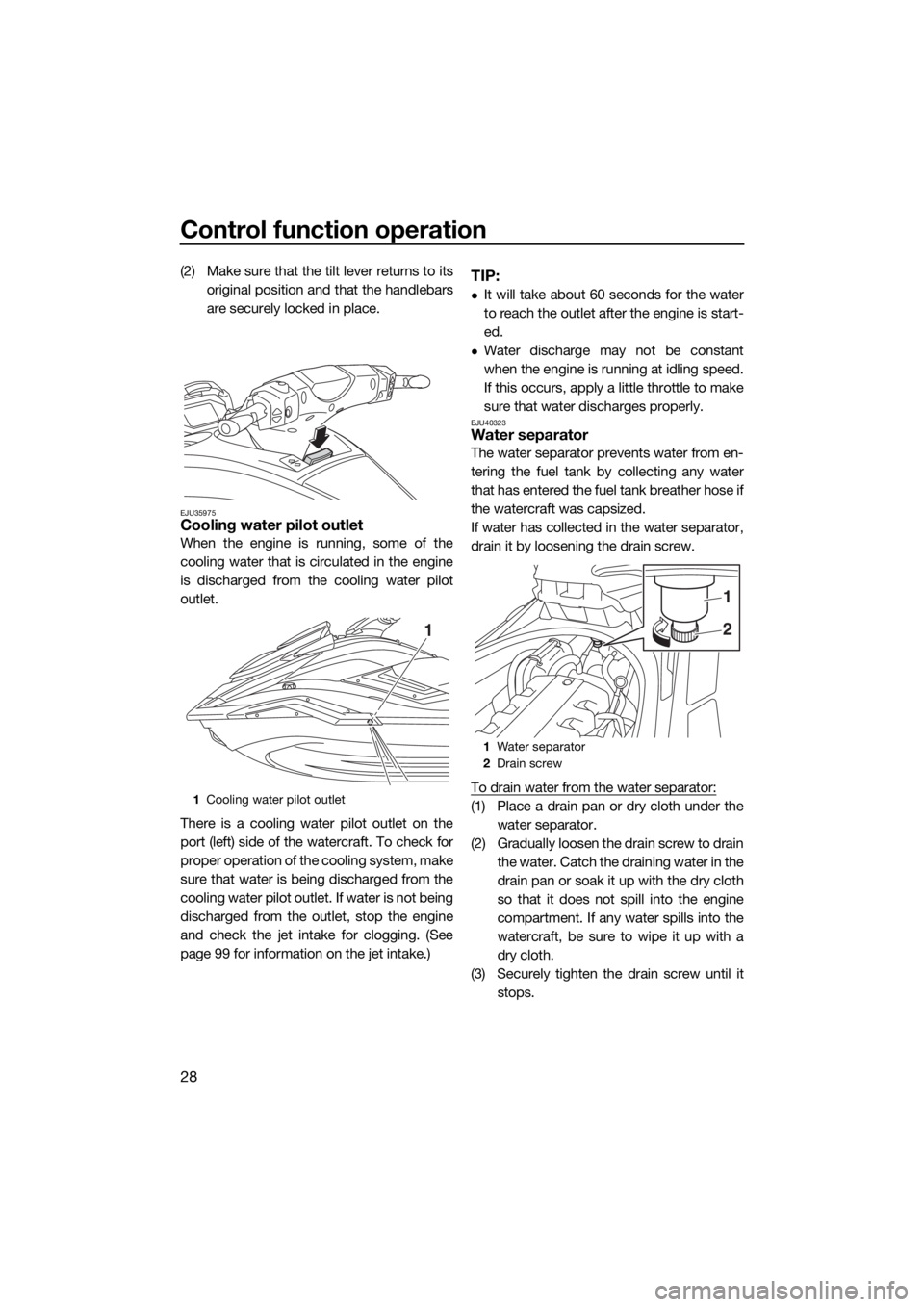
Control function operation
28
(2) Make sure that the tilt lever returns to its
original position and that the handlebars
are securely locked in place.
EJU35975Cooling water pilot outlet
When the engine is running, some of the
cooling water that is circulated in the engine
is discharged from the cooling water pilot
outlet.
There is a cooling water pilot outlet on the
port (left) side of the watercraft. To check for
proper operation of the cooling system, make
sure that water is being discharged from the
cooling water pilot outlet. If water is not being
discharged from the outlet, stop the engine
and check the jet intake for clogging. (See
page 99 for information on the jet intake.)
TIP:
It will take about 60 seconds for the water
to reach the outlet after the engine is start-
ed.
Water discharge may not be constant
when the engine is running at idling speed.
If this occurs, apply a little throttle to make
sure that water discharges properly.
EJU40323Water separator
The water separator prevents water from en-
tering the fuel tank by collecting any water
that has entered the fuel tank breather hose if
the watercraft was capsized.
If water has collected in the water separator,
drain it by loosening the drain screw.
To drain water from the water separator:
(1) Place a drain pan or dry cloth under the
water separator.
(2) Gradually loosen the drain screw to drain
the water. Catch the draining water in the
drain pan or soak it up with the dry cloth
so that it does not spill into the engine
compartment. If any water spills into the
watercraft, be sure to wipe it up with a
dry cloth.
(3) Securely tighten the drain screw until it
stops.1Cooling water pilot outlet
1
1Water separator
2Drain screw
2
1
UF3V70E0.book Page 28 Tuesday, August 28, 2018 10:16 AM
Page 44 of 116
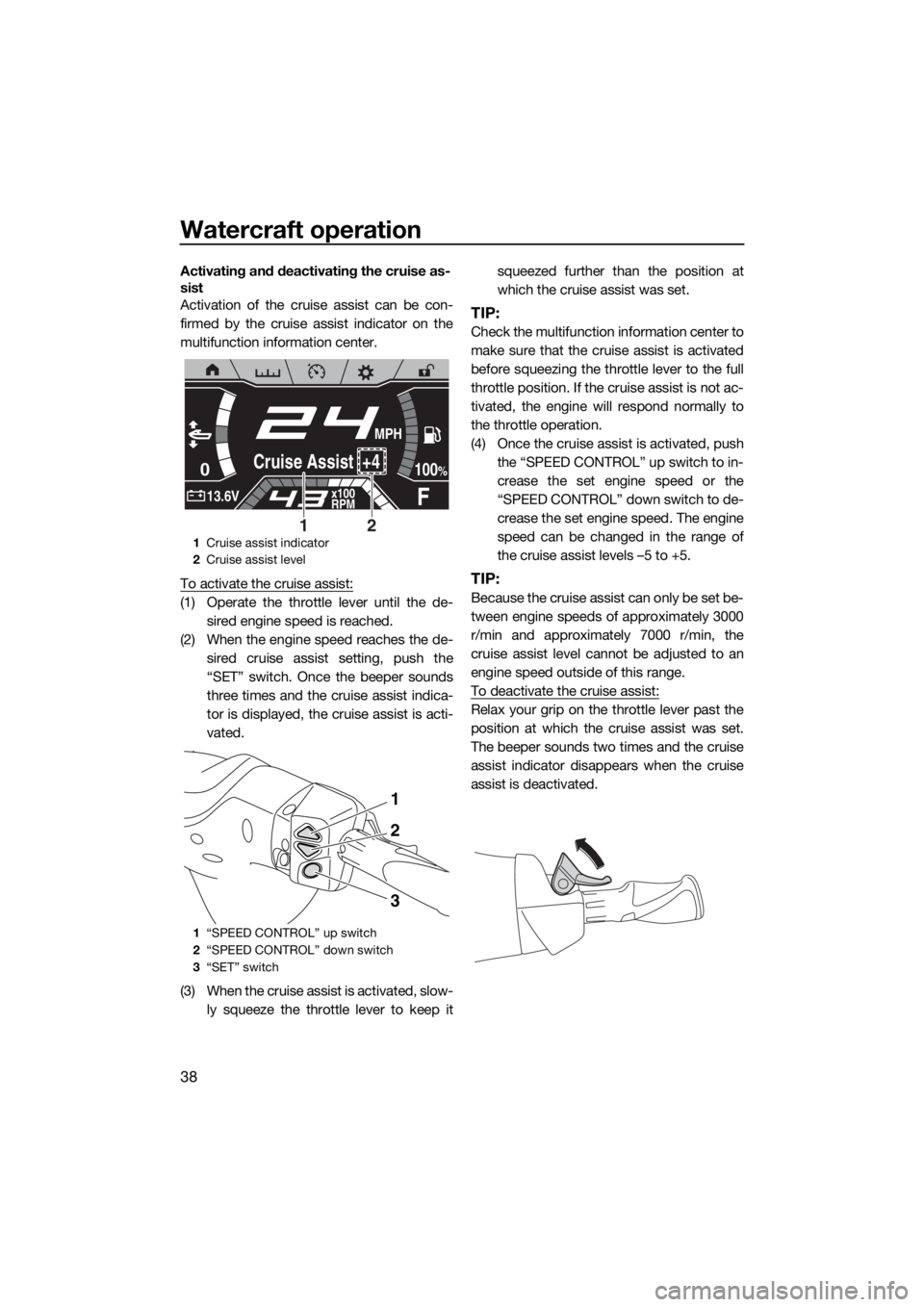
Watercraft operation
38
Activating and deactivating the cruise as-
sist
Activation of the cruise assist can be con-
firmed by the cruise assist indicator on the
multifunction information center.
To activate the cruise assist:
(1) Operate the throttle lever until the de-
sired engine speed is reached.
(2) When the engine speed reaches the de-
sired cruise assist setting, push the
“SET” switch. Once the beeper sounds
three times and the cruise assist indica-
tor is displayed, the cruise assist is acti-
vated.
(3) When the cruise assist is activated, slow-
ly squeeze the throttle lever to keep itsqueezed further than the position at
which the cruise assist was set.
TIP:
Check the multifunction information center to
make sure that the cruise assist is activated
before squeezing the throttle lever to the full
throttle position. If the cruise assist is not ac-
tivated, the engine will respond normally to
the throttle operation.
(4) Once the cruise assist is activated, push
the “SPEED CONTROL” up switch to in-
crease the set engine speed or the
“SPEED CONTROL” down switch to de-
crease the set engine speed. The engine
speed can be changed in the range of
the cruise assist levels –5 to +5.
TIP:
Because the cruise assist can only be set be-
tween engine speeds of approximately 3000
r/min and approximately 7000 r/min, the
cruise assist level cannot be adjusted to an
engine speed outside of this range.
To deactivate the cruise assist:
Relax your grip on the throttle lever past the
position at which the cruise assist was set.
The beeper sounds two times and the cruise
assist indicator disappears when the cruise
assist is deactivated.
1Cruise assist indicator
2Cruise assist level
1“SPEED CONTROL” up switch
2“SPEED CONTROL” down switch
3“SET” switch
0
F13.6Vx100
RPM
100%Cruise Assist +4
MPH
21
1
2
3
UF3V70E0.book Page 38 Tuesday, August 28, 2018 10:16 AM
Page 45 of 116
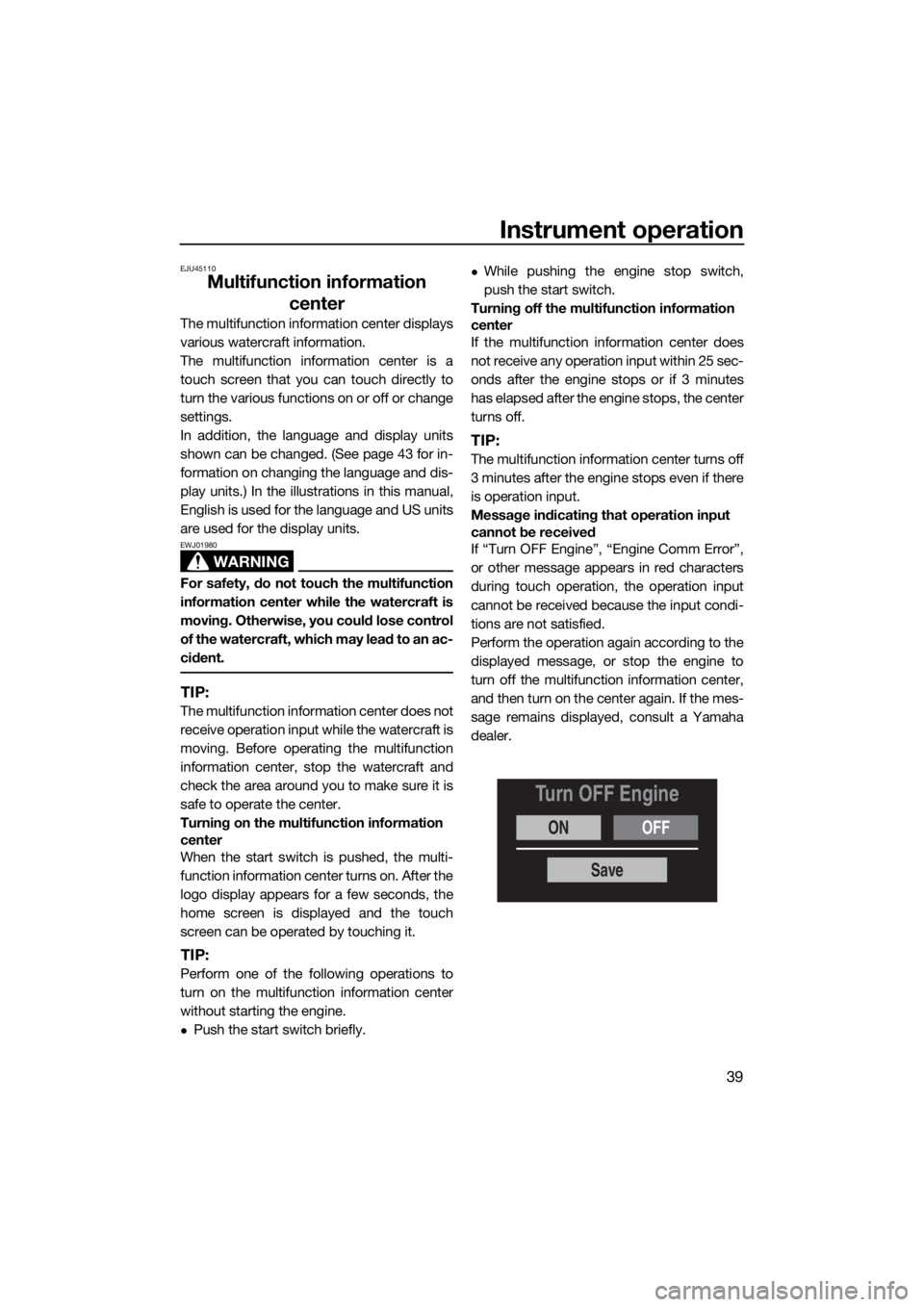
Instrument operation
39
EJU45110
Multifunction information
center
The multifunction information center displays
various watercraft information.
The multifunction information center is a
touch screen that you can touch directly to
turn the various functions on or off or change
settings.
In addition, the language and display units
shown can be changed. (See page 43 for in-
formation on changing the language and dis-
play units.) In the illustrations in this manual,
English is used for the language and US units
are used for the display units.
WARNING
EWJ01980
For safety, do not touch the multifunction
information center while the watercraft is
moving. Otherwise, you could lose control
of the watercraft, which may lead to an ac-
cident.
TIP:
The multifunction information center does not
receive operation input while the watercraft is
moving. Before operating the multifunction
information center, stop the watercraft and
check the area around you to make sure it is
safe to operate the center.
Turning on the multifunction information
center
When the start switch is pushed, the multi-
function information center turns on. After the
logo display appears for a few seconds, the
home screen is displayed and the touch
screen can be operated by touching it.
TIP:
Perform one of the following operations to
turn on the multifunction information center
without starting the engine.
Push the start switch briefly.
While pushing the engine stop switch,
push the start switch.
Turning off the multifunction information
center
If the multifunction information center does
not receive any operation input within 25 sec-
onds after the engine stops or if 3 minutes
has elapsed after the engine stops, the center
turns off.
TIP:
The multifunction information center turns off
3 minutes after the engine stops even if there
is operation input.
Message indicating that operation input
cannot be received
If “Turn OFF Engine”, “Engine Comm Error”,
or other message appears in red characters
during touch operation, the operation input
cannot be received because the input condi-
tions are not satisfied.
Perform the operation again according to the
displayed message, or stop the engine to
turn off the multifunction information center,
and then turn on the center again. If the mes-
sage remains displayed, consult a Yamaha
dealer.
ONOFF
Turn OFF Engine
Save
UF3V70E0.book Page 39 Tuesday, August 28, 2018 10:16 AM
Page 51 of 116

Instrument operation
45
Displaying the time since the last mainte-
nance (“Wellness”)
The total number of hours that the engine has
been running since the last watercraft main-
tenance can be displayed.
To reset the number of hours of operation:
(1) Tap the “Reset” button.
(2) Tap the “Confirm Reset” button to reset
the number of hours of operation.
Resetting the settings, trip information,
and fuel information (“Reset”)
The settings, trip information, and fuel infor-
mation can be reset to their factory default
settings. The items that are reset and the de-
fault settings are as follows.
Display units: US Unit
Language: English
Display brightness: 100%
Color setting: Blue
Trip time: 0.0
Distance traveled: 0.0
Average fuel consumption per gallon or li-
ter: 0.0
Total fuel used: 0.0
To reset the settings, trip information, and
fuel information:
(1) Tap the “Reset” button.
(2) Tap the “YES” button in the confirmation
screen.
EJU45190Engine lock screen “ ”
The engine lock screen shows the setting
screen for the Yamaha Security System in the
center display. (See page 24 for Yamaha Se-
curity System setting procedures.)
EJU45201Warning function
The multifunction information center can indi-
cate the following warnings.
Fuel level warning
Battery voltage warning
Check engine warning
Engine overheat warning
Oil pressure warning
Other warnings (communication errors, ex-
ceeding the maintenance intervals, and so
on)
To stop the buzzer when a malfunction is ac-
tivated, correct the cause of the problem and
Reset
Time Since Last
Maintenance
30.0Hrs
Reset
Reset To
Factory?
UF3V70E0.book Page 45 Tuesday, August 28, 2018 10:16 AM
Page 52 of 116
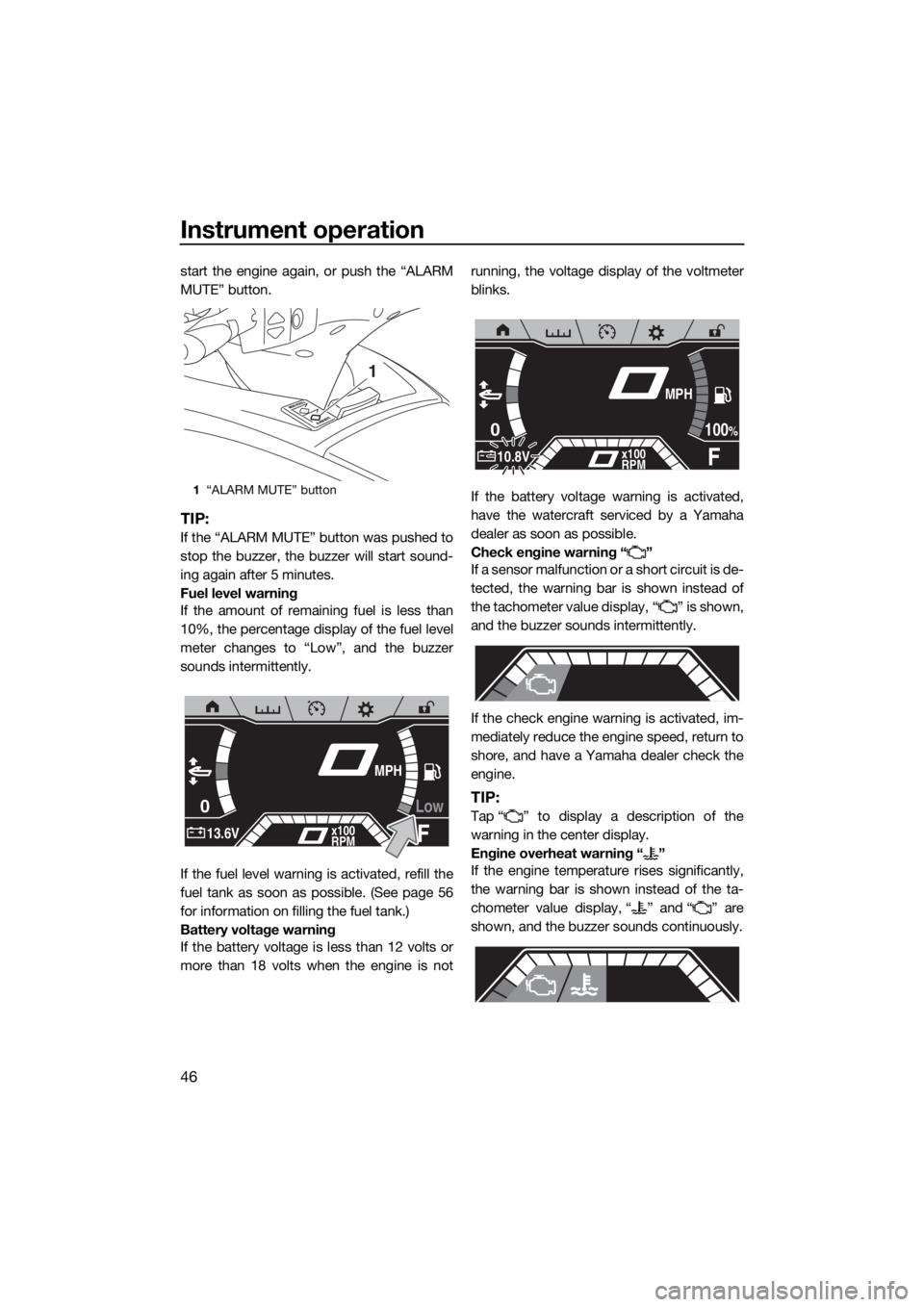
Instrument operation
46
start the engine again, or push the “ALARM
MUTE” button.
TIP:
If the “ALARM MUTE” button was pushed to
stop the buzzer, the buzzer will start sound-
ing again after 5 minutes.
Fuel level warning
If the amount of remaining fuel is less than
10%, the percentage display of the fuel level
meter changes to “Low”, and the buzzer
sounds intermittently.
If the fuel level warning is activated, refill the
fuel tank as soon as possible. (See page 56
for information on filling the fuel tank.)
Battery voltage warning
If the battery voltage is less than 12 volts or
more than 18 volts when the engine is notrunning, the voltage display of the voltmeter
blinks.
If the battery voltage warning is activated,
have the watercraft serviced by a Yamaha
dealer as soon as possible.
Check engine warning “ ”
If a sensor malfunction or a short circuit is de-
tected, the warning bar is shown instead of
the tachometer value display, “ ” is shown,
and the buzzer sounds intermittently.
If the check engine warning is activated, im-
mediately reduce the engine speed, return to
shore, and have a Yamaha dealer check the
engine.
TIP:
Tap “ ” to display a description of the
warning in the center display.
Engine overheat warning “ ”
If the engine temperature rises significantly,
the warning bar is shown instead of the ta-
chometer value display, “ ” and “ ” are
shown, and the buzzer sounds continuously.
1“ALARM MUTE” button
1
Low0
F13.6Vx100
RPM
MPH
0
F10.8Vx100
RPM
100%
MPH
UF3V70E0.book Page 46 Tuesday, August 28, 2018 10:16 AM
Page 53 of 116
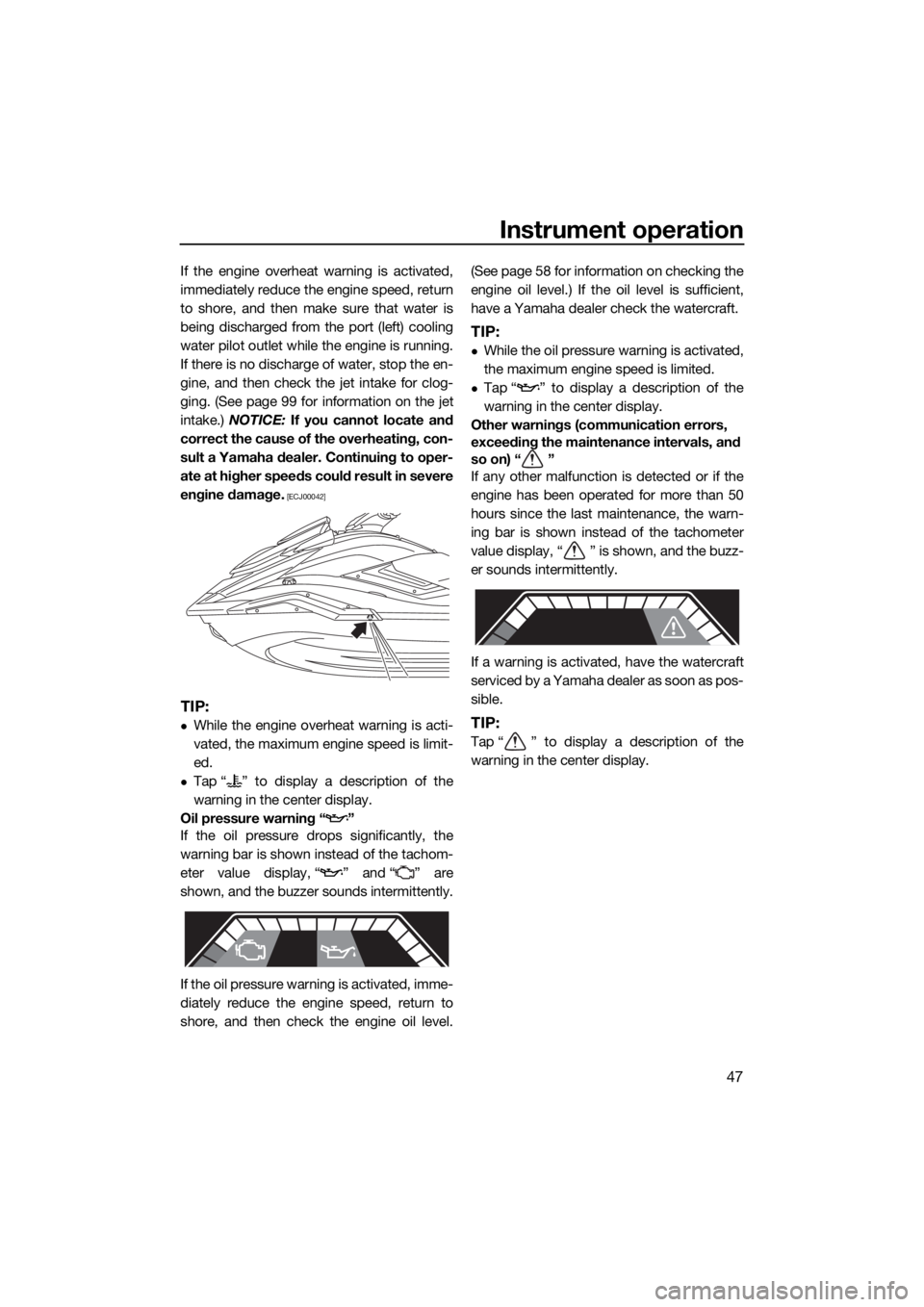
Instrument operation
47
If the engine overheat warning is activated,
immediately reduce the engine speed, return
to shore, and then make sure that water is
being discharged from the port (left) cooling
water pilot outlet while the engine is running.
If there is no discharge of water, stop the en-
gine, and then check the jet intake for clog-
ging. (See page 99 for information on the jet
intake.) NOTICE: If you cannot locate and
correct the cause of the overheating, con-
sult a Yamaha dealer. Continuing to oper-
ate at higher speeds could result in severe
engine damage.
[ECJ00042]
TIP:
While the engine overheat warning is acti-
vated, the maximum engine speed is limit-
ed.
Tap “ ” to display a description of the
warning in the center display.
Oil pressure warning “ ”
If the oil pressure drops significantly, the
warning bar is shown instead of the tachom-
eter value display, “ ” and “ ” are
shown, and the buzzer sounds intermittently.
If the oil pressure warning is activated, imme-
diately reduce the engine speed, return to
shore, and then check the engine oil level.(See page 58 for information on checking the
engine oil level.) If the oil level is sufficient,
have a Yamaha dealer check the watercraft.
TIP:
While the oil pressure warning is activated,
the maximum engine speed is limited.
Tap “ ” to display a description of the
warning in the center display.
Other warnings (communication errors,
exceeding the maintenance intervals, and
so on) “ ”
If any other malfunction is detected or if the
engine has been operated for more than 50
hours since the last maintenance, the warn-
ing bar is shown instead of the tachometer
value display, “ ” is shown, and the buzz-
er sounds intermittently.
If a warning is activated, have the watercraft
serviced by a Yamaha dealer as soon as pos-
sible.
TIP:
Tap “ ” to display a description of the
warning in the center display.
UF3V70E0.book Page 47 Tuesday, August 28, 2018 10:16 AM
Page 62 of 116
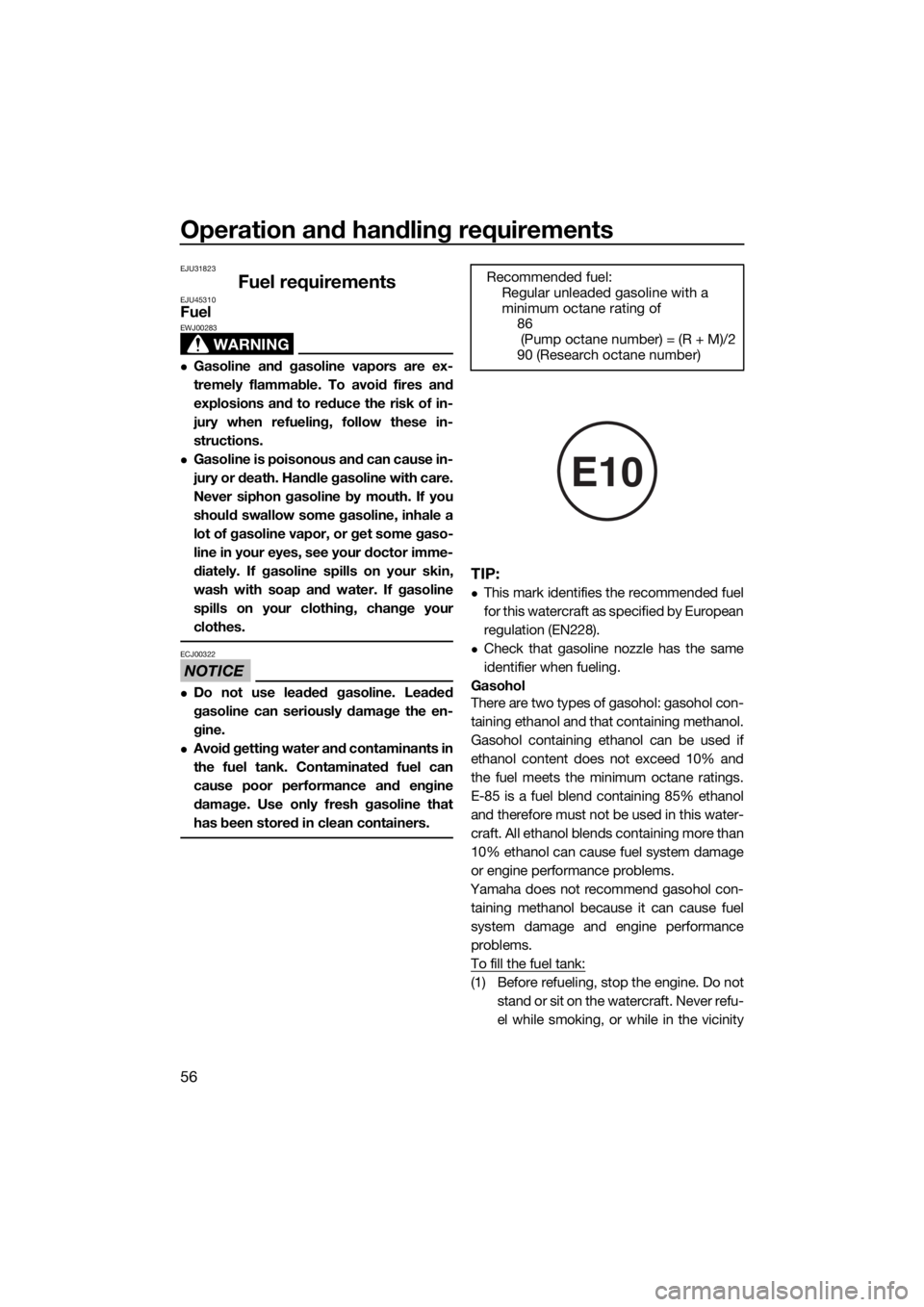
Operation and handling requirements
56
EJU31823
Fuel requirementsEJU45310Fuel
WARNING
EWJ00283
Gasoline and gasoline vapors are ex-
tremely flammable. To avoid fires and
explosions and to reduce the risk of in-
jury when refueling, follow these in-
structions.
Gasoline is poisonous and can cause in-
jury or death. Handle gasoline with care.
Never siphon gasoline by mouth. If you
should swallow some gasoline, inhale a
lot of gasoline vapor, or get some gaso-
line in your eyes, see your doctor imme-
diately. If gasoline spills on your skin,
wash with soap and water. If gasoline
spills on your clothing, change your
clothes.
NOTICE
ECJ00322
Do not use leaded gasoline. Leaded
gasoline can seriously damage the en-
gine.
Avoid getting water and contaminants in
the fuel tank. Contaminated fuel can
cause poor performance and engine
damage. Use only fresh gasoline that
has been stored in clean containers.
TIP:
This mark identifies the recommended fuel
for this watercraft as specified by European
regulation (EN228).
Check that gasoline nozzle has the same
identifier when fueling.
Gasohol
There are two types of gasohol: gasohol con-
taining ethanol and that containing methanol.
Gasohol containing ethanol can be used if
ethanol content does not exceed 10% and
the fuel meets the minimum octane ratings.
E-85 is a fuel blend containing 85% ethanol
and therefore must not be used in this water-
craft. All ethanol blends containing more than
10% ethanol can cause fuel system damage
or engine performance problems.
Yamaha does not recommend gasohol con-
taining methanol because it can cause fuel
system damage and engine performance
problems.
To fill the fuel tank:
(1) Before refueling, stop the engine. Do not
stand or sit on the watercraft. Never refu-
el while smoking, or while in the vicinity Recommended fuel:
Regular unleaded gasoline with a
minimum octane rating of
86
(Pump octane number) = (R + M)/2
90 (Research octane number)
E10
UF3V70E0.book Page 56 Tuesday, August 28, 2018 10:16 AM